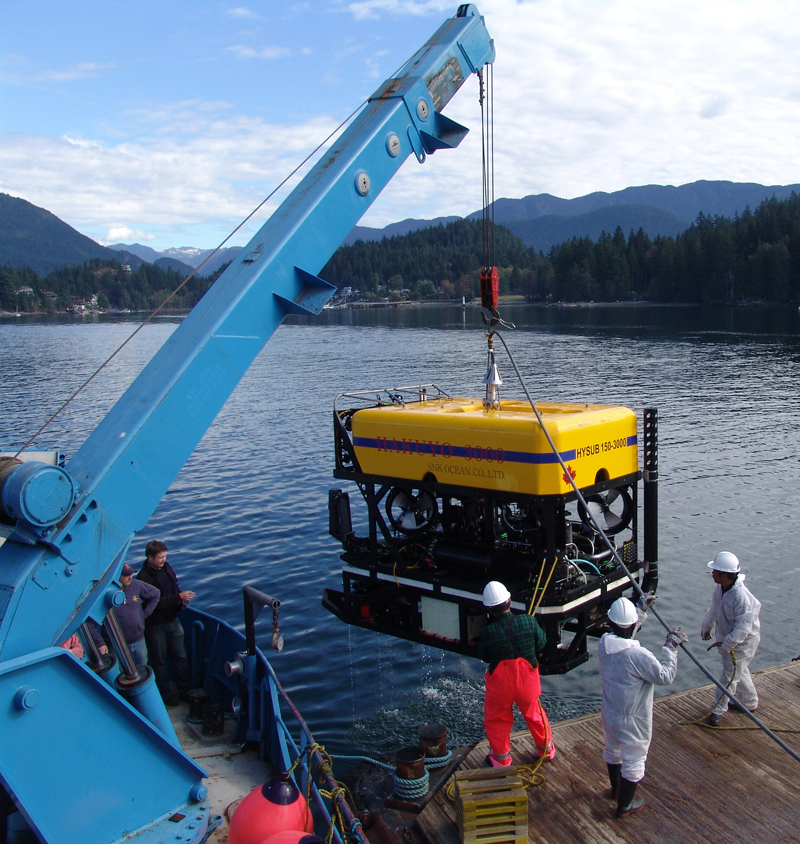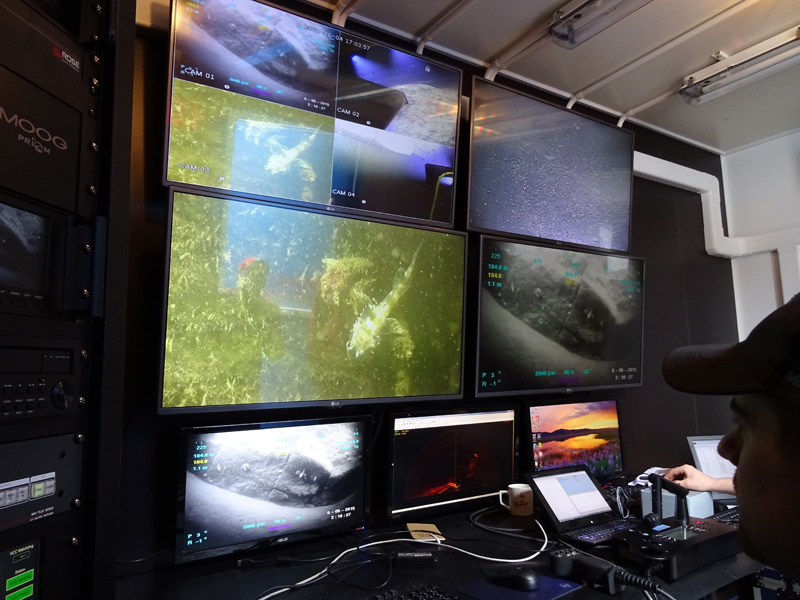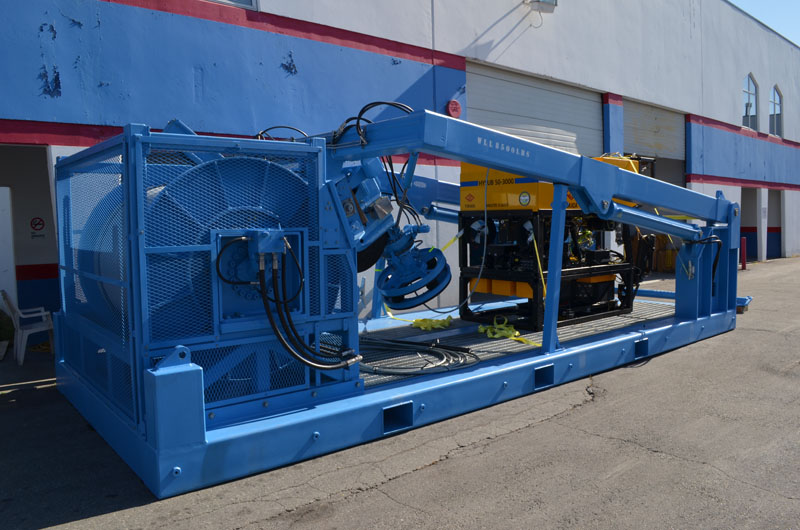August Product Focus - ISE
The HYSUB ROV
By: James A.R. McFarlane, Linda Mackay, Andrew Ronan, P. Eng.,
International Submarine Engineering Ltd.
The HYSUB (HYdraulic SUBmersible) ROV is no stranger to diverse, global subsea markets that include, among other things, oil and gas, military, science, and survey. ISE ROVs are based on a modular design allowing customers the capability of modifying their systems to meet changing mission requirements. The HYSUB ROV design and functionality has evolved over time based on feedback from ISE’s customers and ongoing internal product development. This scalability and adaptive controls methodology has put the ISE HYSUB at the forefront of science/work class category of ROVs.

Fukada Salvage & Marine Works 150HP HYSUB “HAKUYO”.
This month, ISE delivered a custom 50-HP HYSUB ROV to Fukada Salvage & Marine Works, Japan—a custom build that was completed in 4 months. Fukada and ISE have enjoyed an ongoing relationship for over 20 years, with ROV and AUV systems being delivered to them and their customers. The Fukada HYSUBs are named HAKUYO and range from 50 to 150 HP. Today, Fukada operates three ISE ROVs and an ISE Explorer AUV, providing commercial and science operations to a diverse customer base.
The combination of ROVs and AUVs provide Fukada with broad capabilities in the subsea market place. The Explorer AUV allows them to survey broad areas in high resolution, thus identifying targets of value. These survey capabilities are needed for the oil and gas industry, accident location identification, and deep ocean mining operations to name a few. Once specific targets are located, the ROV systems provide the platform for more detailed investigations and sampling operations. As an example, there is currently great interest in the exploitation of seafloor massive sulfides (SMS) mineral deposits. Once the Explorer AUV locates the SMS deposits, the HYSUB ROV will perform high-resolution video imaging quantifying the size of the deposit. Samples are also collected with the ROV either by manipulator or custom rock coring tool sleds mounted to the bottom of the vehicle. Since the AUV can operate in an unsupervised manner, the ship can operate both vehicles simultaneously thus reducing operational costs as a second support vessel is not required.
Science/Work Class Hybrid Design
HYSUB is an electro-hydraulic ROV system composed of components that are selected for functionality and ease of procurement. The electro-hydraulic HPU is sized to allow operators the capacity of adding additional hydraulic sub-systems as required. ISE manufactures HYSUBs from 5 to 250 HP and can meet any operational depth requirements the customer desires. The overall system design is configured for easy access for maintenance and modifications over the life of the system. System reliability is also a major design criteria to ensure maximum operational capacity. With over 40 years of ROV development, ISE has created mature, robust and reliable technology that can be found in all ISE products.
The HYSUB 50-3000 system is a platform that can quickly be modified to meet mission-specific requirements using interchangeable tool sleds. The core vehicle is designed with two fore and aft, two lateral, and two vertical thrusters in a non-vectored or traditional ROV configuration. By eliminating forward vectored thrusters, the vehicle is able to closely approach objects without disturbing the biota under investigation. Vehicles with thrusters in a vectored configuration cannot perform this type of observation, as all horizontal thrusters are active when maneuvering the ROV. Any thruster output will cause water turbidity in front of the vehicle that will impact the environment under investigation. The ISE traditional thruster configuration is superior for performing high-resolution data collection of even the smallest “critters” in benthic and pelagic areas of operation. This is because the vehicle can be positioned without disturbing the water at the front of the ROV.
The standard HYSUB system supports six video channels, four Ethernet interfaces, and 20 serial data ports. The HYSUB provides six 250-W lighting channels; this is upgradeable for users wishing to obtain broadcast quality video for science or documentaries. The telemetry system also integrates altimeter, DVL, ADCP, sonar, depth, acoustic navigation (USBL or LBL), CTD, fluorometer, and other science packages. This extensive capability provides a solid foundation for performing oceanographic research and a very capable offshore work class ROV.
Sampling sub-systems the HYSUB can support are detritus samplers, high flow suction samplers, push cores, rock corers, basalt samplers and sediment bags. The HYSUBs are all equipped with interchangeable tool sleds that provide space for sensors, samplers and experiment packages. By having multiple tool sleds, the operator can reconfigure the ROV for different operations rapidly minimizing operational downtime. The light bars are designed to allow for flexibility in mounting lights, detritus samplers and other science equipment. Other mounting options such as swing arms are available if the operator requires expanded collection capacity.
The HYSUB supports various manipulator packages; two seven-function spatially correspondent manipulators provide the best dexterity for the operator.
Spare power conductors were provided within the umbilical on the new Fukada system to allow for the future addition of a Tether Management System or an auxiliary HPU to power additional tooling such as a dredging skid, suction pump or rock coring systems.
ISE science HYSUBs have passed the test of time showing a return on investment with system longevity. ISE science systems of note that are still in operation today are ROPOS 1986, Ventana 1987, Oceanic Explorer 1998, Hyper-Dolphin (2 units) 1999 and GMGS 2009. The number of dives and total hours of work accomplished by these systems is impressive.
Software and Control
For the new Fukada ROV, ISE provided a custom control van that houses the consoles, video displays, pilot chairs with integrated controllers, winch remote control station, the power distribution unit, boost transformers and HVAC. This control van was purpose built for the new system to the customer’s specifications.

Control Console – Fukada’s 50-HP ROV.
ISE’s flexible software architecture is perfectly suited for systems that need room to grow. The Fukada Hysub-50 was delivered with a basic sensor package that does not support some of ISE’s more advanced functionality. However, the modular architecture allows for that functionality to be activated in the future when new hardware is added.
The latest version of ISE’s control software provides pilots and operators with an unprecedented level of customization. This is of critical importance with a hybrid system such as the Fukada HYSUB-50 where pilots may be called upon to carry out drastically different tasks during a single operation. When transitioning from benthic or pelagic operations, a pilot can easily reconfigure the control interface, button mapping, thruster tuning and display layout to optimize performance and comfort. The recent system also includes an updated Heads Up Display, presenting even more information to pilots while maintaining focus on the task at hand.
Simulator and Control Advances
Control options for HYSUBs now include a 6-DOF vehicle dynamics simulator that is integrated with ISE’s ACE vehicle controller. HYSUB models are “auto-built” from generic vehicle data making it possible to efficiently model not only HYSUB ROVs, but also third-party vehicles. ISE’s new nonlinear model-based ROV controllers make ISE ROVs well suited for mapping applications due to their exceptional smooth depth and station-keeping capability.
Fukada’s 50HP ROV ready to ship together with integrated LARS.
This agility is even evident in the Launch and Recovery system design; this system was manufactured by Sound Ocean Systems in Redmond, Washington. The A-frame and winch skid are configured on a single integrated package, resulting in a small system footprint. This allows for the entire system to be loaded with two lifts, the system skid and the control van. The umbilical is terminated at the top of the ROV through a lifting latch body that allows for safe and easy launch and recovery operations. For the Fukada system, the A-frame was sized to allow the addition of a TMS in the future if required by the operator.
The key to vehicle development is to know what works and what doesn’t—lessons learned over 40 years of experience. ISE works with our customers closely to clearly understand their mission requirements. Just like there is no one-size-fits-all aircraft or automobile, undersea vehicle design and development must consider operational needs. These interactions with customers and our extensive field experience are how the HYSUB ROV has evolved into a highly capable system.
International Submarine Engineering (ISE) was founded in 1974 by Dr. James R. McFarlane, OC, CD, P.Eng, FCAE. Since that time, ISE has manufactured over 300 underwater vehicles that include Remotely Operated Vehicles (ROVs), Autonomous Underwater Vehicles (AUVs) and Human Occupied Vehicles (HOVs). In addition to these underwater vehicles, ISE has also produced semi-submersible vehicles, Unmanned Surface Vehicles (USVs), advanced control systems and diverse robotic systems.


